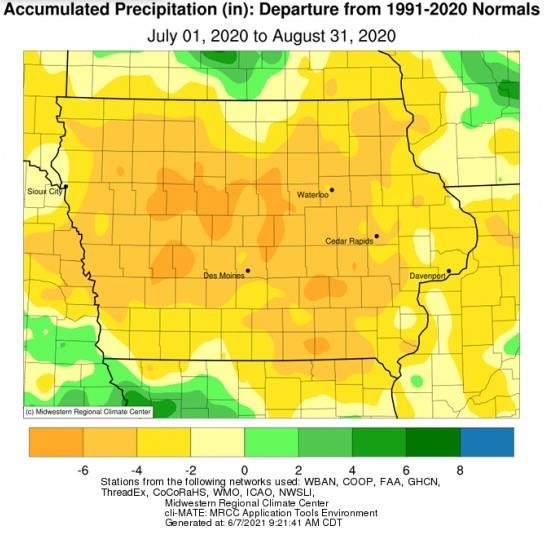Active ingredient | Trade name | Half-life | Availability (KOC) |
fomesafen | Flexstar | 100 days | 60 |
lactofen | Cobra | 3 days | 10,000 |
glufosinate | Liberty | 7 days | 100 |
dicamba | Xtendimax | 14 days | 2 |
glyphosate | Roundup | 47 days | 24,000 |
The relatively long half-life of fomesafen, combined with below average rainfall late-season rain in Iowa, is the reason for the increased issues with carryover in 2021. Much of the state received 4-6+ fewer inches of rain than normal during July and August of 2020 (Figure 1).

The primary symptom of fomesafen injury is striped leaves due to chlorotic or necrotic veins on the leaves (Figures 2, 3, and 4). Other factors can cause striping on leaves, but fomesafen is unique in that the veins are affected rather than interveinal tissue. Some of the leaves may fold over midway due to loss of integrity of the leaf midvein. Frequently only two or three leaves are affected and injured plants recover quickly with no visible injury to subsequent leaves. However, at times there can be stand loss and the only way to determine the potential impact is to determine the percentage of plants affected and closely monitor the rate of recovery.
 Figure 2. Veinal chlorosis typical of fomesafen carryover on corn
Figure 2. Veinal chlorosis typical of fomesafen carryover on corn Figure 3. Fomesafen injury in a 2020 corn field near field entrance due to rate control issues with sprayer in 2019.
Figure 3. Fomesafen injury in a 2020 corn field near field entrance due to rate control issues with sprayer in 2019. Figure 4. Close up image of veinal chlorosis and necrosis on early growth of a corn plant.
Figure 4. Close up image of veinal chlorosis and necrosis on early growth of a corn plant.
While this injury is sometimes unavoidable due to weather conditions, it is often exaggerated by late herbicide applications in soybean. Rather than focusing on the problem of corn injury due to fomesafen, it is more important to consider why late-season applications of postemergence herbicides are required. An integrated program relying on full rates of effective preemergence herbicides with multiple sites of action and early postemergence applications in conjunction with a soil residual herbicide (layered residual program) in soybean, and an increased emphasis on driving down the size of the weed seed bank, should reduce the need for the late-season applications and reduce the likelihood of seeing fomesafen carryover in future years.
Source : iastate.edu